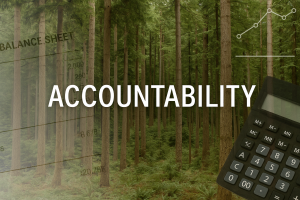True Forest Stewardship is grounded in Financial Accountability
Stewardship is more than sustainable harvest—it is the deliberate, transparent management of forest assets over time.
Financial accountability provides the measurable structure that allows stewardship to endure.
When you purchase forestlands, you are actually purchasing a combination of assets such as land, timber and equipment. Since these assets can be split apart and sold separately, you must go through the process of determining how much of the original purchase price should be allocated to each asset. This is called “Allocating Your Capital to Basis”.
Allocating Your Capital to Basis
While this phrase may sound intimating it is really just a way of saying that when you purchase forestlands you are really purchasing a minimum of 2 discrete assets; land and timber. In some cases landowners actually purchase a total of 4 types of assets; land, equipment, timber, and depreciable real property improvements. Because we can separate these 4 types of investments apart from the others, it is necessary to determine how much we invested in each separate investment. This way, we can determine the actual gain on selling timber apart from the land, or we can determine how much of our investment is available for depreciation (equipment).
This seemingly daunting task is not actually as complicated as you might think. However, it is absolutely necessary that you follow a series of steps, in order, to come to the right answer.

Step 1:
Fair Market Value
The first step in this process is to determine the Fair Market Value of the individual assets. This is different from the purchase price of each asset. If we think about it, there is a difference between FMV and purchase price. Each of us gets a good deal or a bad deal on an item and therefore our purchase price does not always equal the FMV.
Land:
Determining land value can be challenging or straightforward depending on the characteristics of the land. When we determine the FMV of land we have to consider what use determines the highest and best use of that particular parcel. Much of the forestland in the west is best suited to growing timber. However, as communities continue to grow and expand into the forested areas of the countryside, the highest and best use of forestlands often is not to grow timber, but to be subdivided and sold as housing lots. In these cases the purchaser must determine what is the highest and best use of the land and apply that value to the FMV of the land.
If the highest and best use of the property is for growing timber products, then landowners can use a formulae called the Soil Expectation Value formulae to determine the value of the land portion of the asset.
Equipment:
When dealing with something like equipment the FMV is generally a reasonable estimation of market value. Think of this as a “blue book” on an automobile. It can be the “going rate” or appraised value of equipment on the date of acquisition.
Timber:
The timber value on the site is also fairly straightforward to determine. We need to determine the volume of timber on the site as of the date of acquisition. If the property was acquired this year, then you can use the current volume on the site. If the asset was acquired some time in the past, then you will need to go through the process of determining the volume at the date of acquisition. We call this an “After the Fact Adjustment”.
The other item we need to determine is the value of the timber at the time of acquisition. This should be a stumpage value, that is, the value that the landowner would net from the proceeds of selling the timber less all expenses of harvest such as logging, trucking, and consulting forester fees. The State Department of Natural Resources or Department of Lands in your area often has a record of past stumpage values that are useful if you are trying to determine the value of stumpage in your area from some time in the past.
Once we have the volume of timber on the site at acquisition and the value of stumpage on the property at acquisition we can multiply them together to get the fair market value of the timber at acquisition.
Depreciable Real property Improvements:
These items are physical improvements to the land that have a useful life and are depreciable in their nature. It includes items such as fences, buildings, culverts and even some roads. The critical part of these assets is that value in these accounts is depreciated each year as the asset is worn out in the production of income. Some parcels of forestlands do not include any “DRPI”.

Step 2:
Purchase Price:
At first glance, you might think that the purchase price is simply what you have paid for the parcel. However, you should add to this figure, the costs of acquisition. These normally include ordinary and necessary expenses made to purchase the parcel and include items such as: timber cruise, land survey, legal assistance, title insurance, and other similar items. The result is that it increases the total purchase price of the timber.
How You Acquired Your Forestlands
So far, we have discussed the issues of setting the original basis as if you had purchased your property. However, some landowners acquired their property through inheritance or received it as a gift. The determination of the correct original basis is influenced by how you acquired your property.
Purchased Property
If the forest landowner purchased the parcel, he or she should record the actual amount paid to acquire the asset, including acquisition costs, such as timber cruises, property surveys, legal advice, and other expenses necessary to complete the purchase of the property.
Inheritance
For inherited parcels, the original basis is the valuation reported on the federal estate tax return or state death tax return. If neither figure is available, record the original basis as the fair market value on the deceased’s date of death. If the decedent’s estate chose a special use valuation on the inherited property, then the original basis is that amount used in the special use valuation.
When the value of the forest land is determined through the fair market value on the date of death, the recipient receives a “stepped-up” basis. The “stepped-up” basis has advantages over an unchanged basis because it increases from the date of original purchase to the date of death. The higher the basis, the higher the deduction allowed when that property is sold or disposed of by the recipient.
Gifts
Forest lands received as a gift retain the giver’s basis. Unlike the basis for inherited timber, this basis is not stepped up on the date the gift is received. The recipient uses the basis maintained by the giver.
ADJUSTED BASIS
The original basis changes as financial activity begins on the property. This change will modify specific accounts to reflect purchases and other types of financial activity. The term “adjusted basis” describes this change in basis value after the date of acquisition.
Forest Accountability

